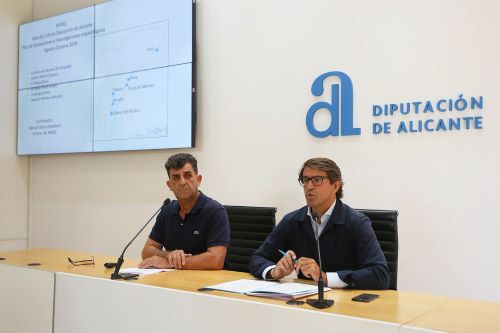
The MARQ will launch, for yet another year, the Plan for archaeological excavations and investigations at six enclaves of the province. An initiative that, with a budget of 114,000 euros, contributes to the increase and preservation of the historical and cultural heritage of the province.
The Deputy for Culture, Juan de Dios NavarroThis morning, he presented the details of this campaign accompanied by the director of the Museum, Manuel OlcinaThe Diputación remains firmly committed to archaeological research through this extensive programme at half a dozen sites, located in the north, south and centre of the province, which cover periods from prehistory to the late Middle Ages and provide us with excellent tools to delve deeper into our past as a territory and learn about our history," he said.
Coordinated by Olcina, the plan has the collaboration of 27 volunteers and fulfils the objective of documenting and realising a extensive scientific research of the findingsand to advance our knowledge of the ancient civilisations that inhabited different enclaves of the territory. The work will last between three and five weeks from August to October. As the director of the MARQ pointed out, "this is one of the pillars of our museum activities which, moreover, is one of the most powerful actions carried out by a Spanish museum".
Illeta dels Banyets in El Campello. Iberian Period (4th-3rd c. BC)
Located in El Campello, this site has been occupied for a long time, from prehistoric times to the Roman period. In this edition, as a continuation of the previous campaign, the excavation will focus on the Iberian structures (4th-3rd centuries BC) in the central area of the enclave with the aim of finding out about the construction systems and metrology used. Under the direction of Olcina and Adoración MartínezThe work will take four weeks and will have a budget of 23,000 euros.
Cabezo Molino de Rojales. Hermiral period (8th-10th centuries)
This site spans from Late Antiquity to the beginning of the Middle Ages, from the Islamic period (6th to 9th centuries), and this year will continue with the excavation of the 6th century necropolis, most probably linked to people from the eastern Mediterranean (Eastern Roman Empire or Byzantines). An important part of this project is the anthropological study and DNA analysis of the corpses found. Under the direction of Juan Antonio López Padilla and Teresa Ximenez de Embún19,000 will be spent over a period of four to five weeks.
The Tabayà of Aspe. Prehistory, Argar culture
This important site of the Argar culture (second millennium BC) is a village built on a rough elevation that was probably a watchtower and control post for the natural passage that for centuries constituted the course of the Vinalopó, connecting the Mediterranean coast with the inland lands. The team led by López Padilla will work for five weeks to try to find out in greater detail the cultural characteristics of this prehistoric period. The project has a budget of 23,000 euros.
Tossal de Manises in Alicante. Roman period (1st century AD).
This year, supported by a budget of 3,000 euros, it is planned to carry out only anthracological analyses - wood - with the aim of finding out the plant species existing in the area during Antiquity.
The Alcudia of Elche. Iberian and Roman city
With an important Iberian occupation, on top of which a Roman colony was built, with the population surviving until the beginning of the Middle Ages, La Alcudia is one of the most important archaeological sites in Spain. The intervention will consist of cleaning the structures of the western thermal baths that formed the western front of the city in order to obtain an accurate diagnosis of the state of conservation with which to draw up a comprehensive consolidation and museum project. Eventually, archaeological surveys could be carried out to determine the state of conservation of some of the walls or pavements. The structures are currently in an advanced state of degradation, with the walls and paving in danger of collapse, and this action will be the beginning of the definitive recovery of this important building of the Roman Ilici. Under the direction of Olcina, Rafael Pérez (Area de Arquitectura de la Diputación), Ana Ronda and Mercedes Tendero (Fundación Universitaria La Alcudia de Investigación Arqueológica, FUAIA, dependent on the University of Alicante), the work will last for five weeks and will have a budget of 23,000 euros.
Pobla d'Ifac de Calp. Late medieval period (14th century).
The MARA's nineteenth excavation at this site will focus on delimiting Building XIV, a structure outside the city walls, whose function is still unknown and which is annexed to the western entrance to La Pobla. Completing the excavation of this building and documenting its function will be the main objective of the campaign directed by José Luis Menendez Fueyo which will run for five weeks and is endowed with 23,000 euros.
